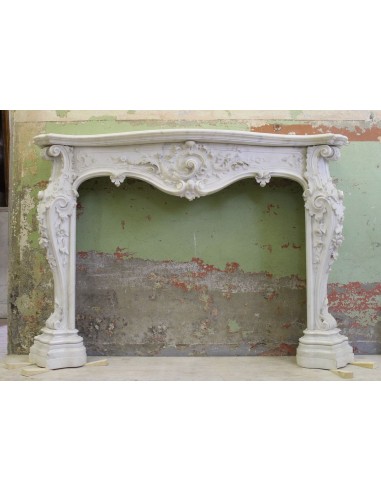WERE ALSO BORN ON THE ARNO RIVERSIDE BOTTICELLI'S PRIMAVERA, LEONARDO'S MONA LISA OR, ALWAYS IN THE FIELD OF SCULPTURE, OUR MICHELANGELO’S DAVID, OUR DONATELLO, OUR VERROCCHIO ETC.
I DON'T MEAN TO THROW IT INTO THE JOKE BY WRITING... “WILL IT BE THE AIR!?” BUT THERE IS NO DOUBT THAT FLORENCE HAS BEEN, STARTING WITH THE RENAISSANCE (OF WHICH IT WAS EVEN THE CRADLE) AN INCREDIBLE, IMPRESSIVE AND FASCINATING FORGE OF ALL THE KNOWN ARTS, A DIVINE CRUCIBLE THAT HAS HAD NO EQUAL IN THE ENTIRE GLOBE.
ALSO IN FLORENCE IS THE BIRTHPLACE OF THE FIREPLACE THAT I AM PRESENTING HERE.
IT MAY NOT HAVE BEEN DESIGNED BY MASACCIO AND SCULPTED BY DONATELLO (JUST TO NAME TWO OTHER EXPONENTS OF FLORENTINE ART), BUT IT REMAINS AN EXEMPLARY FLORENTINE OF GREAT DESIGN AND SCULPTURAL QUALITY.
LET US TRY TOGETHER TO IMAGINE AND RECONSTRUCT, AS FAR AS POSSIBLE, THE FANTASTIC HISTORY OF OUR FIREPLACE:
Many people do not know that Florence was the capital of Italian Art Nouveau..
I write Art Nouveau and not “Arte Floreale” as I have instead written in the title of this card because, while it is true that at the beginning Liberty was called Art Nouveau in its homeland of origin, England, Art Nouveau in France and Arte Floreale in Italy, it is also true that very soon (let's say more or less from the year 1900 onwards) this fantastic floral stylism conformed worldwide to the title “Liberty.”
Several Florentine architects, starting in 1880, breathed the scent of the Art Nouveau winds, working in their homeland but also (and with much artistic profit) in Liguria (especially in the coastal cities) and as far as the French Riviera.
I write of the architects because, in the case of the villas built in the Liberty period and style, it was ALWAYS they, the architects, who designed every ornament of the house, including the fireplace and furniture.
The architect who designed this fireplace started from afar, from 17th-century Florentine Baroque, light-handed, and very fine, in contrast to the excessively heavy decorative load that Baroque could often offer (not always, but often) in other parts of Italy.
From this stylistic moment, our “Archi” took the structure of the fireplace...
I do not exclude that some influence on the design of this fireplace (I am always referring to its architecture and not to the added decorations) is also due to the work of the Parisian Ateliers des Arts, which surely our Archi was familiar with but, even so, it is evident how our “designer” wanted to find his own stylistic autonomy, so much so that the front of the fireplace does not have the two classic (and absolutely unfailing in French design) “breasts” descending on the front, but a single, very sweet and apt “down”.
Most pleasing (and present only in the Italian design/design of each sculpture), the “wrought background” that is, indeed, the background of each sculpted figure. A “workshop” refinement, which served to give greater prominence, accomplice the play of light and shadow, to the sculptures from that particular background arising.
In short, our Archi was really good at drawing, as well as a profound connoisseur of craft techniques and of the happy “cleverness” of the Tuscan master sculptors.
He was therefore in good hands as the commissioning owner of that villa, which, judging by the fireplace we are examining, must have been at least...fantastic.
Normally a patron, when agreeing with the Archi of the case HOW to make his own fireplace, had only one right: That of giving a tip, an address, of expressing, in short, a kind of unique and therefore also ultimate wish as to what to do.
Those who asked to be allowed to insert family coats of arms (usually fake or shabby patches), those who asked to express their “political” opinion (this was the case with many Masons.. How many mantels have I found, in almost half a century of research in this world, with the five-pointed star or the square and compass, the triangle also known as "delta," the lead and/or the level etc... etc... ), those, again, who wished to signify, with the sculptures on the mantelpiece, the field of their activity (moneylenders with the symbol of the pawnshop, vine-dressers with vine-shoots, blacksmiths with the symbols of their Corporation, which in Florence were hammer and tongs, in other places hammer and anvil etc...). Those who tried to “embellish” (perhaps even to ingratiate themselves with divine benevolence..) their mantelpiece with religious symbolism, those who asked for the affixing of sculptures symbolizing virtues more or less usurped (but placed in the window as a certain patrimony of that family) or simply virtues that one wished to attain, a sort of wish given to oneself.
Our patron belonged to the latter category.
It is very clear, in fact, the manifestation of this intention, since the sculpture we are looking at is half “quilted” with bluebells and the other half with daisies.
And if this floral display could not be lacking in that Art which, indeed, expressly called itself “Floral,” it should be borne in mind that in antiquity (at least until World War II) it was impossible to execute sculptural works without meaning. It was not in the mindset of the men of that time, much less the artists of that time.
INTERLUDE/OUTBURST/INABILITY TO SHUT UP:
There was Poetry, in this “conceptual” drawing, in this sculpting of marble amidst white dust and artistic sweats....
Since the last world war these concepts have been lost altogether, the brain mangled by television and cell phones, bombarded by incessant stupid advertising, disheartened brutalized raped by an increasingly rampant ignorance.
MEANINGS OF THE FLOWERS AFFIXED TO OUR FIREPLACE:
The daisy...has few clear meanings, always connected with the concept of Truth.
It is the flower of purity and innocence, simplicity and modesty, but also of faithful love and patience.
In particular, this flower symbolizes youthful innocence, free from guilt, sin, and corruption. In fact, it was once commonly picked in meadows by maidens and tucked into the locks of their hair.
The bellflower... is a strong and “pioneer” plant; it springs up and proliferates where almost all other plants fail.. Above all, it symbolizes Perseverance in trying to achieve the goals we set for ourselves.
HERE THEN IS THE THOUGHT OF THE ANCIENT FIRST OWNER OF THIS SCULPTURE:
WAS OR HOPED TO BE PURE, MODEST AND SINCERE....
WAS OR HOPED TO BE STRONG AND PERSEVERING ON THE PATH OF HIS GOALS.
I wish the next owner to possess these virtues.
IDENTITY CARD OF THE FIREPLACE I AM INTRODUCING:
A) IT WAS BORN IN FLORENCE AROUND THE YEAR 1890.
B) IT IS DRESSED IN THE NOBLEST WHITE MARBLE (IN THE WORLD), CARRARA STATUARY.
C) IT IS IN MORE THAN PERFECT CONDITION.
604 AG ANTIQUE EXCEPTIONAL FLORAL ITALIAN FIREPLACE MANTEL IN STATUARY MARBLE
Louis XV
€27,000.00
No tax
SHARE ON:
Description
Reviews (0)
No reviews














































































